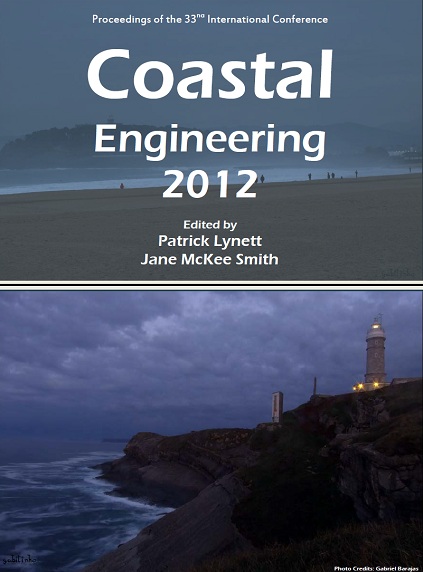Abstract
Typical practice for a century has been to transport dredged sand to an offshore disposal site in deep water where the sediment is lost from the littoral system. The alternative of nearshore placement can retain the sand, but the fate of the material is poorly understood. A set of laboratory experiments were conducted, using tracer sand, with the intent of quantifying the migration of material with alternative dredged mound placements within the surf zone. Conventional depth-integrated tracer sand transport models can utilize a correction factor or a gradient diffusion mechanism to represent the effects of the depth variation. In the surf zone, however, an analytical correction factor is not available and a gradient diffusion coefficient is arbitrary with no physical basis. An alternative simple advective transport sand model is introduced herein that explicitly predicts both the advection associated with the return current and the wave-related onshore transport. With a simple framework based on a suspended layer and a bedload layer of arbitrary transport directions, the Taylor dispersion of tracer sand is explicitly computed without any dependence on a diffusion mechanism. Both the modeled and measured results indicate transport directed offshore by the undertow, onshore by the wave asymmetry, and down-drift as forced by the longshore current.References
Dalrymple, R.A. 1992. "Prediction of storm/normal beach profiles," Journal of Waterway, Port, Coastal and Ocean Engineering, ASCE, 118(2),193-200.http://dx.doi.org/10.1061/(ASCE)0733-950X(1992)118:2(193)
Johnson, B., and Grzegorzewski, A.S. 2011. "Modeling Nearshore Morphologic Evolution of Ship Island During Hurricane Katrina," Proceedings of Coastal Sediments 2011, World Scientific, 1797-1810.
Hamilton, D.G., B.A. Ebersole, E.R. Smith, and P.Wang. 2000. "Development of a large-scale laboratory facility for sediment transport research," Technical Report, ERDC/CHL TR-01-22, Vicksburg, MS.
Kobayashi, N., and B.D. Johnson. 2001. "Sand suspension, storage, advection and settling in surf and swash zones," Journal of Geophysical Research, 106(C5) 9363-9376.http://dx.doi.org/10.1029/2000JC000557
Kobayashi, N., Payo, A., and Schmied, L. 2008. "Cross-Shore Suspended Sand and Bedload Transport on Beaches,"Journal of Geophysical Research, 113, C07001, doi:10.1029/2007JC004203http://dx.doi.org/10.1029/2007JC004203
Kobayashi, N., Payo, A., and Johnson, B.D. 2009."Suspended sand and bedload transport on beaches," Handbook of Coastal and Ocean Engineering, World Scientific. Chapter 28, 807-823.http://dx.doi.org/10.1142/9789812819307_0028
Kobayashi, N., Zhao, H. and Tega, Y. 2005. "Suspended Sand Transport in Surf Zones", Journal of Geophysical Research, 110, C12009, doi:10.1029/2004JC002853.http://dx.doi.org/10.1029/2004JC002853
Nielsen, P., 1992. Coastal Bottom Boundary Layers and Sediment Transport.World Sci., River Edge, NJ.
Smith, J.M., Sherlock, A.R., and Resio, D.T. 2001. "STWAVE: steady-state spectral wave model user's guide for STWAVE." Special Report ERDC/CHL-01-01 US Army Engineer Research and Development Center, Vicksburg, MS.

